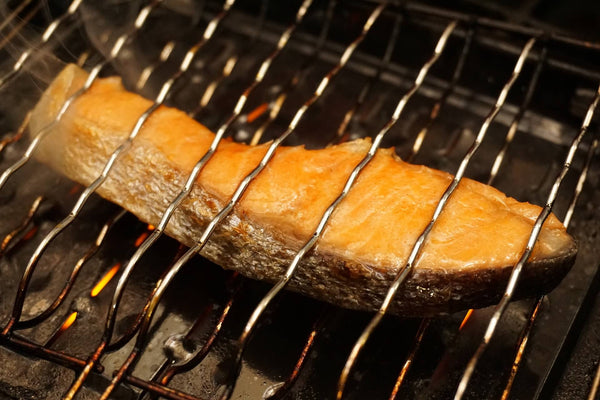How Long to Broil Salmon
Updated on Aug 25, 2023
Trying new cooking techniques can be daunting, especially if you’re unfamiliar with them. If you’re wondering how long to broil salmon, our quick and nifty guide has the answers for you!
We’ll tell you what temperatures work best, how to prevent overheating, and how to tell when your fish is done.
How Long to Broil Salmon?
Broil salmon for approximately 4-6 minutes per 1/2 inch (1.25 cm) of thickness. For fillets that are around 1 inch thick, aim for about 6-8 minutes. Always monitor the cooking process closely to avoid overcooking.
What Temperature to Broil Salmon at?
There is no specific temperature for broiling salmon. Instead, the broil setting on an oven heats the top element to high heat.
This intense direct heat cooks the salmon quickly. Position the oven rack so the salmon is about 4-6 inches (10-15 cm) away from the broiler element, and cook until the salmon flakes easily and reaches an internal temperature of at least 145°F (63°C).
What's the Difference Between Baking and Broiling Salmon?
Baking yields a more gentle and even cooking process, while broiling offers a quicker option with a unique texture and flavor profile.
Baking involves cooking salmon in an oven at a consistent temperature, often around 350-400°F (175-200°C), which evenly cooks the fish from all sides.
Broiling, on the other hand, uses intense direct heat from the top element of the oven, positioned close to the salmon. This results in quick cooking with a charred and slightly crispy exterior, while the interior remains tender.
How Do I Prevent Salmon From Drying Out When Broiling?
To prevent salmon from drying out when broiling, try these tips:
- Brush with oil: Lightly brush the salmon with olive oil or melted butter to create a protective barrier and retain moisture.
- Use a marinade: Marinate the salmon for about 30 minutes before broiling to infuse flavor and moisture.
- Monitor cooking time: Broil for the recommended time based on thickness, usually 4-6 minutes per 1/2 inch. Overcooking can lead to dryness.
- Position correctly: Place the salmon about 4-6 inches from the broiler to allow even cooking without excessive direct heat.
By following these suggestions, you can enjoy tender and flavorful broiled salmon without the risk of it becoming dry.
How Do I Know When Broiled Salmon is Done?
You can tell when broiled salmon is done by checking its internal temperature and texture. Insert a fork or a thin knife into the thickest part of the fillet and gently twist. If the flesh flakes easily and appears opaque throughout, it's done.
You can also use a food thermometer to measure the internal temperature; salmon should reach at least 145°F (63°C) to ensure it's cooked safely.
Frequently Asked Questions
Can I broil frozen salmon?
While you should thaw salmon before cooking for even results, you can broil frozen salmon and still yield a good cook.
Can I broil salmon with aluminum foil?
You can broil salmon with aluminum foil to prevent direct exposure to the intense broiler heat, reducing the risk of the salmon becoming overly charred or dry.
Do I need to preheat the broiler before cooking the salmon?
It's generally recommended to preheat the broiler before cooking salmon to ensure that the broiler element reaches its maximum temperature before you place the salmon under it. Preheating achieve the desired cooking results, such as proper browning and even cooking. The process takes about 5-10 minutes, giving you enough time to prepare the salmon fillets and the baking sheet.
Do I need to flip the salmon when broiling?
There's often no need to flip salmon when broiling. The intense heat from the broiler cooks the salmon quickly and effectively from the top, resulting in a nicely browned and slightly crispy top layer while keeping the interior moist and tender. Flipping the salmon can disrupt this process and lead to uneven cooking or potentially cause the fillet to fall apart.
Can I broil salmon with the skin on?
Yes, you can broil salmon with the skin on. The skin acts as a protective barrier during broiling, helping to keep the flesh moist and preventing it from sticking to the baking sheet. When broiling, position the salmon skin side down on the baking sheet. The skin will become crispy and flavorful during cooking, adding to the overall texture and taste of the dish.
If you prefer your salmon skin-off, refer to our guide on how to remove salmon skin.
Conclusion
Now that you know how long to boil salmon, it’s time to put your skills to the test. Don’t forget to share your best recipes with us!
Of course, a good broil starts with a good cut of salmon. With our wild Alaskan sockeye salmon, you can’t go wrong with a signature broil!








